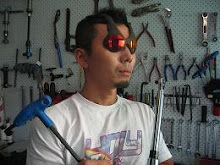I had two racers brought to me several weeks ago for servicing and degreasing the drivetrain. One of the bikes wasn't too bad (but still needed to have the chain, cassette and chainrings replaced), but the other bike was in more serious condition.
 The bike came with a Bontrager Select wheel set which is the entry model in the range. I believe this set was used for about two years and the side wall of the rim was concaved (as you can see in the picture) due to wear from the brakepads while they are braking. This wasn't the only reason. When a tyre is inflated to around 100psi in this situation, the rim cannot withstand the force of the air pressure on it, and it will bend and not be able to hold the tyre in place.
The bike came with a Bontrager Select wheel set which is the entry model in the range. I believe this set was used for about two years and the side wall of the rim was concaved (as you can see in the picture) due to wear from the brakepads while they are braking. This wasn't the only reason. When a tyre is inflated to around 100psi in this situation, the rim cannot withstand the force of the air pressure on it, and it will bend and not be able to hold the tyre in place.Most of the recent rims come with some kind of mark on the side wall surface, something like a "." or "X" or even a line in the middle. So you can judge that the rim is nearing the end of its life once the marks disappear. If you keep using the rims, ignoring this warning, you could end up with serious injuries. The tyre can be blasted, or this paper-thin side wall can become very sharp debris if it tears off. And these could happen while you are riding... you may come off the bike, cut your leg with the torn sharp rim or involve other riders when you are riding in a group. You could cause many disasters.
I assessed these bikes beforehand to prepare all the parts I needed to replace. This meant I didn't need to keep the customer's bike for 1 or 2 weeks until the parts arrive and also they can keep riding in the meantime as long as it's safe enough. And the work progresses smoothly, too.
The customer requested to have the drivetrain degreased and to do service. So I removed the front & rear derailleurs, crankset, cassette sprocket, chain and bottom bracket from the bike. I disassembled, degreased, cleaned up, re-greased, assembled, adjusted then installed the parts to the bike. In particular, it was very important to overhaul the rear derailleur mount pivot and guide plate pivot to improve shifting performance.
 It doesn't get too dirty around this area but you can see black grease (Shimano uses lime green grease at the factory) on the pivot shaft in the picture. The wet black colour is still ok (but not good). If it's dry black, that's a cautionary signal. If it's started to become brown, that's a red signal. The brown means rust. Luckily this time it didn't affect the derailleur enough to warrant replacing the whole thing so I removed the rust as much as I could.
It doesn't get too dirty around this area but you can see black grease (Shimano uses lime green grease at the factory) on the pivot shaft in the picture. The wet black colour is still ok (but not good). If it's dry black, that's a cautionary signal. If it's started to become brown, that's a red signal. The brown means rust. Luckily this time it didn't affect the derailleur enough to warrant replacing the whole thing so I removed the rust as much as I could. Lastly, I checked over the whole bike, replaced a few cables and took it out for test ride then all the work was complete. It took a massive amount of time and I had to concentrate for long hours but it is always worth it when customers are back on their wheels and I hear how they are enjoying their cycling.









